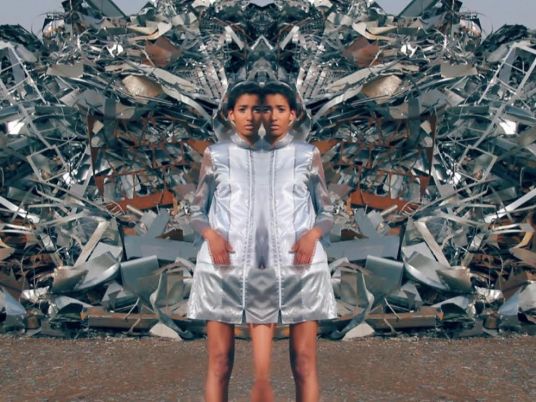An uncompromising and radical style is evident in the first solo exhibition of young painter Hala el-Sharouni, “In Absentia,” held at the Cairo Atelier. In fact, el-Sharouni’s artwork engages more than just one style, as the artist willfully transitions between strokes inspired by Picasso sketches, the disturbing grace of Egon Schiele’s characters, and the colors of African and South American art.
28-year-old el-Sharouni asserts the right to express herself in a variety of manners. Her approach to art contradicts the education she received at Helwan Art School. “The teachers insist that we pick one school of art that appeals to us and stick to it in the long term,” explains the artist, who is currently enrolled in a master’s program at the same university, specializing in painting and drawing.
El-Sharouni happily dismisses what she calls “rules that confine artistic expression,” choosing the most exuberant tones of red, orange, yellow, blue, and green she can find to apply on the nude canvas.
“There are some pieces I cannot remember painting,” she says. “I sometimes experience a kind of blackout when I paint, only to find myself staring at a finished piece.”
El-Sharouni put art on hold between 2006 and 2008 when she immersed herself in the world of the stock exchange, becoming a trader “to make a living,” she says. That was until she seized a canvas in a frenzy and painted on it the ample purple and red strokes of “More,” the most psychadelic work on display in the exhibition, and the piece that brought her back to what she loves the most: painting.
In another piece is a woman dressed in a tight-fitting blue dress. “She is divided in a diptych, to highlight the gap in her soul,” explains el-Sharouni, who separated the top part of the subject’s body from the lower, slicing her vertically into two. The curvaceous body of the woman is slightly crouching, with an erotic plump belly and slender legs arranged. The woman savors the long cigarette she holds between her fingers, her lippy mouth ready to inhale the gray smoke. “This painting is very aggressive, all the lines are hard, straight and dark,” explains the painter. “This is my mother,” she adds.
“I draw my inspiration mostly from my family and my failed relationships, and through my paintings I judge people in their absence and they judge me, hence the name of my exhibition, “In Absentia,” says el-Sharouni.
“Tea for Two” depicts two women sitting on a couch, two cups of tea steaming on the table nearby. One is pregnant and clutches her protruding stomach with her hands in a warm and protective gesture, while the other woman holds a cat.
The serene atmosphere that might otherwise be evoked by this painting is contradicted by the furtive glances exchanged by the women. Their shifty eyes provoke uneasiness. El-Sharouni says that she herself is represented in this take on a more classical composition. “I am the woman holding the cat,” she explains, adding that she is “jealous of my pregnant friend, who in turn envies my solitary condition.”
El-Sharouni employs bold and furiously vibrant colors to accentuate the sadness of her work. “I like this contrast between the pure, radical colors and the sadness that I paint,” she says, turning to “Stay,” a painting that depicts a couple clasped in an embrace, desperately resisting an imminent separation. The use of bright colors and the shapes of the subjects arouse a South-American feel, a connection with the art of Cuba or Mexico.
El-Sharouni embraces a “no-styles-attached” philosophy in a triptych that resembles a Picasso sketch. “I am greatly influenced by the way Picasso draws his portraits. I am particularly fascinated by his unhesitating, abrupt lines,” she says, standing in front of the series of expressionistic portraits dominated by blue and oranges lines.
Two paintings hanging side-by-side, “Hiding I” and “Hiding II,” demonstrate another aspect of el-Sharouni’s artistic personality: her attraction to earthy colors and African art. Two wide, blank eyes with drooping eyelids appear among a fabulous mix of spirals, triangles, cubes and curves that cover the canvas. “The colors I used for these pieces are more earthy and discreet, because this was my first attempt working with oil and I felt too shy to use bold colors,” says the artist.
El-Sharouni’s work is displayed until the 19th of February in L’Atelier Gallery from 5pm to 11pm.
From 5 PM to 11 PM
Cairo Atelier, 2 Karim el-Dawla Street, Downtown
02-25746730




